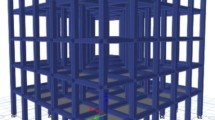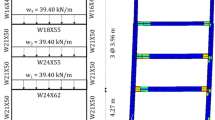Abstract
Permanent displacement of slopes is key data for designing the slope in performance-based seismic design. To estimate the permanent displacement of a slope, empirical as well as numerical methods should be adopted. However, the results of these methods are highly dependent on both stationary and nonstationary ground-motion characteristics. This paper aims to find the most influential nonstationary characteristics of earthquakes on the permanent displacement of slopes. Two different numerical methods, Newmark’s sliding-block and response-history analysis, are used for a total of 47 real earthquake records. The records are classified into three groups based on their event characteristics. They are spectrally matched before analysis to the target spectrum to eliminate the effect of stationary characteristics. The amount of permanent displacement obtained from the analyses is different for varying input motions. The intensity-based parameters, destructiveness potential factor, Arias intensity, and characteristic intensity play an important role on the permanent displacement of the slope. The results of this study are expected to yield judgment criteria for designers to select appropriate ground motion to evaluate the permanent displacement of slopes under seismic loading.
Similar content being viewed by others
References
Ang, A. H. S. (1990). “Reliability bases for seismic safety assessment and design.” Proc. 14th U.S. National Conf. on Earthquake Engrg., EERI, Palm Springs, Vol. 1, pp. 29–45.
Arias, A. (1970). A measure of earthquake intensity, MIT Press, Massachusetts, USA, pp. 438–483.
ASCE (2000). Seismic analysis of safety-related nuclear structures and commentary, American Society of Civil Engineers, Reston, VA, USA, DOI: https://doi.org/10.1061/9780784404331.
ASCE (2006). Minimum design loads for buildings and other structures, SEI/ASCE 7–02, American Society of Civil Engineers, Reston, VA, USA.
Atik, L. A. and Abrahamson, N. (2010). “An improved method for nonstationary spectral matching.” Earthquake Spectra, Vol. 26, No. 3, pp. 601–617, DOI: https://doi.org/10.1193/1.3459159.
Bommer, J. J. and Acevedo, A. B. (2004). “The use of real earthquake accelerograms as input to dynamic analysis.” Journal of Earthquake Engineering, Vol. 8, No. S1, pp. 43–91, DOI: https://doi.org/10.1080/13632460409350521.
Bommer, J. J. and Martínez-Pereira, A. (1999). “The effective duration of earthquake strong motion.” Journal of Earthquake Engineering, Vol. 3, No. 2, pp. 127–172, DOI: https://doi.org/10.1080/13632469909350343.
Benjamin, J. R. (1988). A criterion for determining exceedance of the operating basis earthquake, EPRI Report NP-5930. Electric Power Research Institute. Palo Alto, CA, USA.
Bishop, A.W. (1955). “The use of the slip circle in the stability analysis of slopes”, Géotechnique, Vol. 5, No. 1, pp. 7–17, DOI: https://doi.org/10.1680/geot.1955.5.1.7.
Catalán, A., Climent, A. B., and Cahís, X. (2009). “Selection and scaling of earthquake records in assessment of structures in low-to-moderate seismicity zones.” Soil Dynamics and Earthquake Engineering, Vol. 30, pp. 40–49, DOI: https://doi.org/10.1016/j.soildyn.2009.09.003.
CEN (2003a). Eurocode 8: Design of structures for earthquake resistance. Part I: General rules, EN1998-1:2004, European Committee for Standardization, Brussels, Belgium.
CEN (2003b) Eurocode 8: Design of structures for earthquake resistance. Part II: Bridges, EN1998-2:2004, European Committee for Standardization, Brussels, Belgium.
Crespellani, T., Madiai, C., and Vannucchi, G. (1998). “Earthquake destructive potential factor and slope stability.” Géotechnique, Vol. 48, No. 3, pp. 411–419, DOI: https://doi.org/10.1680/geot.1998.48.3.411.
EPPO (2000). Greek code for seismic resistant structures — EAK2000. Earthquake Planning and Protection Organization, Athens, Greece. (in Greek).
FEMA (2009). NEHRP Part 1: Recommended provisions for seismic regulations for new buildings and other structures, FEMA P-750, Federal Emergency Management Agency, Washington D.C., USA. Ed
Garini, E. and Gazetas, G. (2012). “Destructiveness of earthquake ground motions: Intensity measures versus sliding displacement.” Proc. 2nd Int. Conf. on Performance-based Design in Earthquake Geotechnical Engrg., Taormina, Italy, Paper No. 7.07.
Geoslope International (2018). Geostudio 2018 R2, https://www.geoslope.com. [Accessed on August 21, 2017].
Housner, G. W. (1959). “Behavior of structures during earthquakes.” Journal of Engineering Mechanics Division, ASCE, Vol. 85, No. 14, pp. 109–129.
Idriss, I. M. (1995). Assessment of site response analysis procedures, Report No. NIST GCR 95–667, National Institute of Standards and Technology, Gaithersburg, Maryland, MD, USA.
Itasca C. G. (2013). FLAC3D User’s Guide Ver. 5.0, Itasca C.G, Minneapolis MN, USA.
Kalkan, E. and Luco, N. (2011). “Special issue on earthquake ground-motion selection and modification for nonlinear dynamic analysis of structures.” Journal of Structural Engineering, Vol. 137, No. 3, DOI: https://doi.org/10.1061/(ASCE)ST.1943-541X.0000355.
Katsanos, E. I., Sextos, A. G., and Manolis, G. D. (2010). “Selection of earthquake ground motion records: A state-of-the-art review from a structural engineering perspective.” Soil Dynamics and Earthquake Engineering, Vol. 30, No. 4, pp. 157–169, DOI: https://doi.org/10.1016/j.soildyn.2009.10.005.
Kim, M. K., Lee, S. H., Choo, Y. W., and Kim, D. S. (2011). “Seismic behaviors of earth-core and concrete-faced rock-fill dams by dynamic centrifuge tests.” Soil Dynamics and Earthquake Engineering, Vol. 31, No. 11, pp. 1579–1593, DOI: https://doi.org/10.1016/j.soildyn.2011.06.010.
Kim, J. K., Kim, H. J., Lee, J. H., and Heo, T. M. (2016). “Development of Korean standard horizontal design spectrum based on the domestic and overseas intra-plate earthquake records.” Journal of the Earthquake Engineering Society of Korea, ISSN 1226-525X, Vol. 20, No. 6, pp. 413–424 (in Korean), DOI: https://doi.org/10.5000/EESK.2016.20.6.413.
Kramer, S. L. (1996). Geotechnical earthquake engineering, Prentice Hall, Upper Saddle River, New Jersey, USA.
Lee, J. S., Chae, H. G., Kim, D. S., Jo, S. B., and Park, H. J. (2015). “Numerical analysis of inverted T-type wall under seismic loading.” Computers and Geotechnics, Vol. 66. pp. 85–95, DOI: https://doi.org/10.1016/j.compgeo.2015.01.013.
Lee, J. S., Choo, Y. W., and Kim, D. S. (2013). “Numerical seismic response of single-degree-of-freedom structure supported by shallow foundation.” Proc. of the 3rd Int. FLAC/DEM Symposium, Hangzhou, China Upper Saddle River, New Jersey.
Lin, T. and Baker, J. (2011). “Probabilistic seismic hazard deaggregation of ground motion prediction models.” Proc. of 5th Int. Conf. on Earthquake Geotechnical Engrg., Santiago, Chile, pp. 10–13.
Makdisi, F. I. and Seed, H. B. (1978). “Simplified procedure for estimating dam and embankment earthquake-induced deformations.” Journal of the Geotechnical Engineering Division, ASCE, Vol. 104, No. GT7, pp. 849–859.
Mejia, L. H. and Dawson, E. M. (2006). “Earthquake deconvolution for FLAC”, Proc. of 4th Int. FLAC Symposium on Numerical Modelling in Geomechanics, pp. 4–10, ISBN 0-9767577-0-2.
MOIS (2018). Common applications for seismic design, MOIS, Ministry of the Interior and Safety, Seoul, Korea (in Korean).
Newmark, N. M. (1965). “Effects of earthquakes on dams and embankments.” Géotechnique, Vol. 15, No. 2, pp. 139–160, DOI: https://doi.org/10.1680/geot.1965.15.2.139.
Nozu, A., Ichii, K., and Sugano, T. (2004). “Seismic design of port structures.” Journal of Japan Association for Earthquake Engineering, Vol. 4, No. 3-SP, pp. 195–208.
Nuttli, O. W. (1979). The relation of sustained maximum ground acceleration and velocity to earthquake intensity and magnitude, Miscellaneous Paper S-71–1, Report 16, U.S. Army Corps of Engineers, Waterways Experiment Station, Vicksburg, Mississippi, USA.
Protezione Civile (2003). Norme tecniche per il progetto, La valutazione E L’adeguamento sismico degli edifici. No. 3274, Order of the President of the Council of Ministers, Italy.
Saragoni, G. R., Holmberg, A., and Sáez, A. (1989). Potencial destructivoy destructividad del terremoto de Chile de 1985, 5as Jornadas Chilenas de Sismología e Ingeniería Antisísmica, Santiago, Chile, Vol. 1, pp. 369–378.
Sarma, S. K. (1971). “Energy flux of strong earthquakes.” Tectonophysics, Vol. 11, No. 3, pp. 159–173, DOI: https://doi.org/10.1016/0040-1951(71)90028-X.
Sarma, S. K. and Yang, K. S. (1987). “An evaluation of strong motion records and a new parameter A95.” Earthquake Engineering and Structural Dynamics, Vol. 15, No. 1, pp. 119–132.
Schnabel, P. B., Lysmer, J., and Seed, H. B. (1972). SHAKE: A computer program for earthquake response analysis of horizontally layered sites, Report No. UCBIEERC-72/12, Earthquake Engineering Research Center, University of California, Berkeley, CA, USA.
Seed, H. B. and Idriss, I. M. (1970). Soil moduli and damping factors for dynamic response analysis, Report No. UCB/EERC-70/10, Earthquake Engineering Research Center, University of California, Berkeley, CA, USA.
Seismosoft Ltd. (2018). Seismomatch, http://www.seismosoft.com/, [Accessed on August 21, 2017].
Silva, W. J. and Lee, K. (1987). State-of art for assessing earthquake hazards in the United States (WES RASCAL Code for Synthesizing Earthquake Ground Motions), Paper S-73–1, United States Army Corps of Engineers, MISC, Washington, D.C., USA.
Standard New Zealand (2004). Structural design actions-Part 5: Earthquake actions-New Zealand, NSZ 1170.5:2004, Technical Committee BD-006-04-11, Wellington, New Zealand.
Von Thun, J. L., Rochim, L. H., Scott, G. A., and Wilson, J. A. (1988). “Earthquake ground motions for design and analysis of dams.” Earthquake Engineering and Soil Dynamics II — Recent Advances in Ground-Motion Evaluation, Geotechnical Special Publication, ASCE, Reston, VA, USA, Vol. 20, pp. 463–481.
Acknowledgements
This research was supported by the project entitled “Development of performance-based seismic design technologies for advancement in design codes for port structures,” funded by Ministry of Oceans and Fisheries of Korea and by grant (NRF-2017R1D1A1A09000525) from the National Research Foundation of Korea.
Author information
Authors and Affiliations
Corresponding author
Rights and permissions
About this article
Cite this article
Lee, J., Liu, Q. & Park, HJ. Effect of Earthquake Motion on The Permanent Displacement of Embankment Slopes. KSCE J Civ Eng 23, 4174–4189 (2019). https://doi.org/10.1007/s12205-019-1833-0
Received:
Revised:
Accepted:
Published:
Issue Date:
DOI: https://doi.org/10.1007/s12205-019-1833-0




